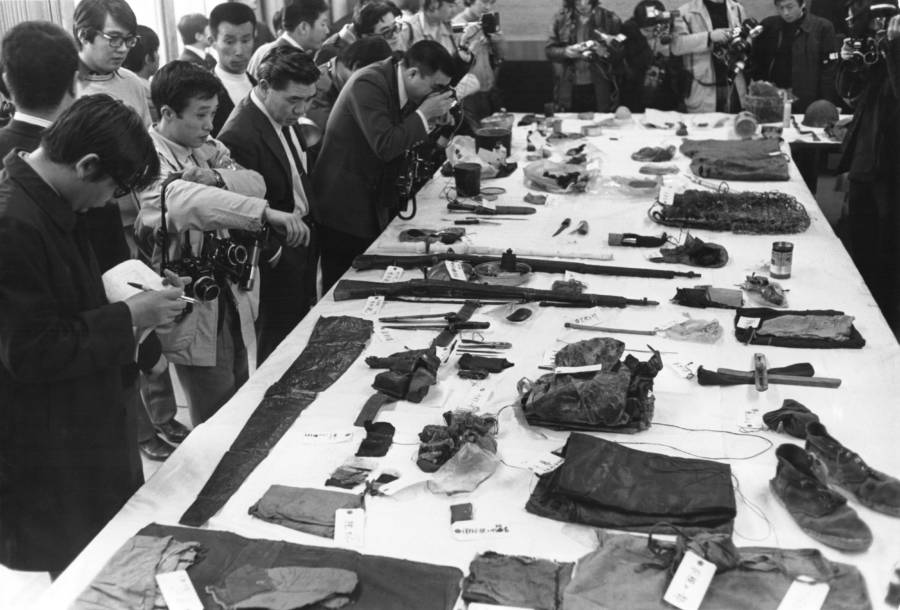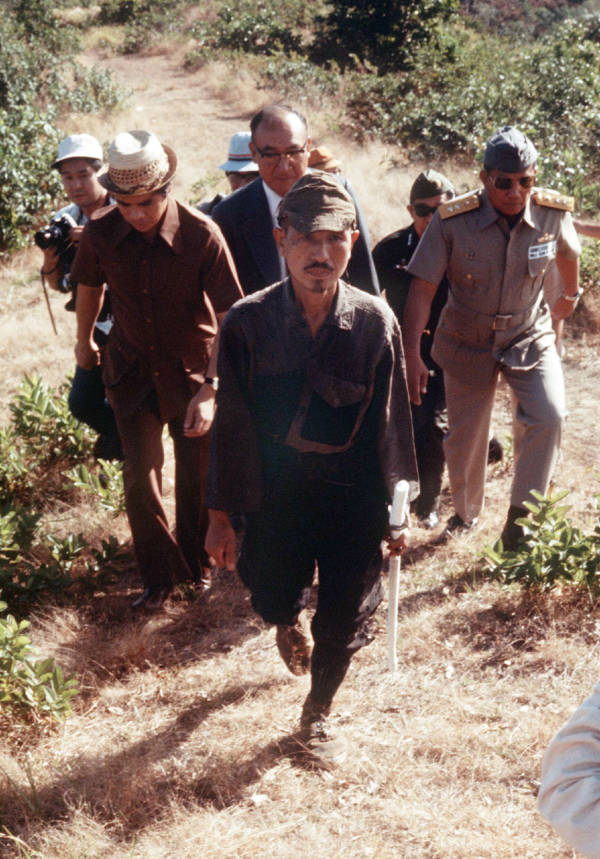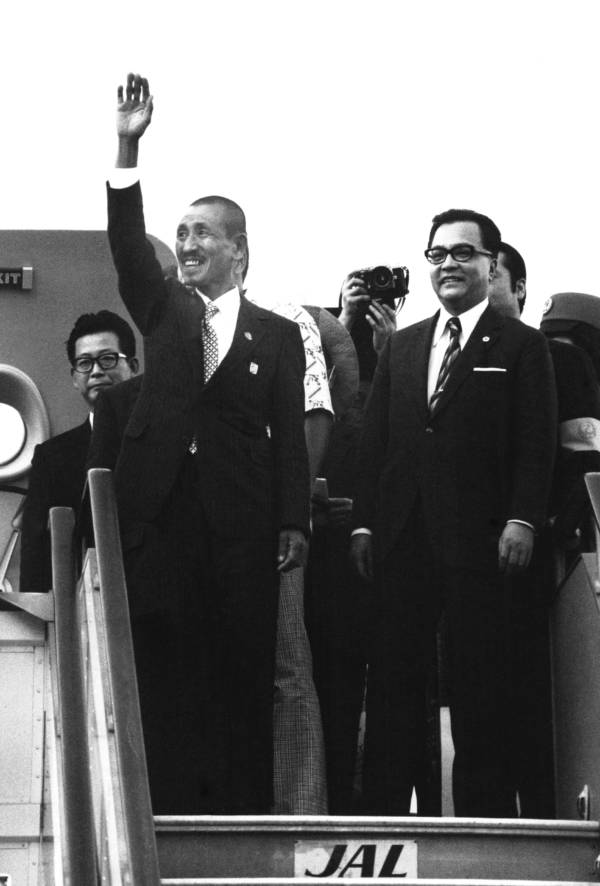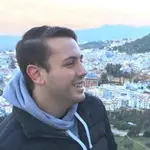For 29 years after the conflict had ended, Japanese soldier Hiroo Onoda hid out in the jungles and continued waging a war that was long over with.
The story of Hiroo Onoda is one of dedication and courage as well as stubbornness and delusion.
Hiroo Onoda was one of the last Japanese soldiers to stop fighting World War II — 29 years after the Imperial Japanese Army surrendered to the Allies aboard the U.S.S. Missouri on September 2, 1945.

JIJI PRESS/AFP/Getty ImagesImperial Japanese Army soldier Hiroo Onoda offers his military sword to Philippine President Ferdinand Marcos to express his surrender at the Malacanan Palace in Manila on March 11, 1974.
Onoda was born on March 19, 1922, in the village of Kamekawa in the Wakayama prefecture of Japan. “I was always defiant and stubborn in everything I did,” Onoda later said of his childhood.
He was also one in a long line of warriors, dating all the way back to his samurai ancestors and continuing up to his father, a sergeant in the Japanese cavalry who fought and died in the Second Sino-Japanese War in China.
Onoda followed the same path as his forebears and enlisted in the Imperial Japanese Army when he turned 18, just one year before Japan would go to war with the United States following the attack on Pearl Harbor.

Wikimedia CommonsHiroo Onoda as a young officer in 1944.
In the army, Onoda trained as an intelligence officer in the commando class “Futamata” at the Nakano School, a military training center that specialized in teaching unconventional military techniques, including guerrilla warfare, sabotage, counterintelligence, and propaganda.
The skills that Onoda gained from his unique training would come in handy when he was sent to Lubang Island in the Philippines after the end of his training in December of 1944.
Two years earlier, the Imperial Japanese Army had taken control of the Philippines, wresting control from the Philippine government and the American forces stationed in the nation. However their army was spread thin, and when the U.S. embarked on a counter-invasion of the island nation in early 1944, they quickly began pushing back the Japanese.
By the winter of 1944, many of the Japanese troops were forced out of the major islands of the Philippines and had retreated to the smaller islands of the Philippine archipelago, like Lubang Island.
With his training in guerrilla warfare tactics, Hiroo Onoda was sent to the small island on December 26, 1944, in order to use his particular skills to hold off the American and Philippine troops for as long as possible.
Thus, Onoda used a technique that the Japanese had been trying in which, when their outposts were close to defeat in conventional warfare, they would retreat to the woods to engage in guerrilla attacks.
The intent was to prevent U.S. troops from making strong footholds in the region, delaying their ability to move closer to Japan, and giving the Imperial Japanese Army more time to regroup and prepare for attacks. These guerrilla units, which also acted as spies, would also continue to be a thorn in the Allies’ side.

Keystone-FranceGamma-Rapho/Getty ImagesHiroo Onoda in the jungles of Lubang Island. Date unspecified.
However, when Hiroo Onoda arrived on the island, the officers there, who outranked Onoda, refused to let him carry out his assignment, opting instead to fight invading troops head-on.
As a result, when the American troops landed on the small island on February 28, 1945, the Japanese forces there attempted to fight them and were quickly defeated.
Seeing their impending defeat, Onoda located three fellow soldiers (Private Yūichi Akatsu, Corporal Shōichi Shimada, and Private First Class Kinshichi Kozuka), and ordered them into the woods with him to engage in his guerrilla war.
And Hiroo Onoda carried on this guerilla war for the next 29 years.
He and his men survived on a diet of stolen rice, coconuts, and meat from cattle slaughtered during farm raids carried out when he wasn’t attacking nearby Philippine troops.
In August of 1945, as the war between Japan and the U.S, came to an end, Onoda had noticed a lull in the fighting but did not suspect that his home nation had surrendered. So he continued with his private war, killing local farmers, and even engaging in shootouts with the police when they were sent after him.
Knowing the existence of these Japanese guerrilla units, who had no method of communication with the central military command, the United States made several efforts to make sure the news of Japan’s surrender reached these holdouts, including the airdropping of explanatory leaflets.

United States Office of War InformationLeaflet airdropped by the United States informing Japanese troops of Japan’s surrender.
Hiroo Onoda and his men first came across a U.S. leaflet announcing the end of the war and the surrender of Japan in October 1945. However, he quickly dismissed the document as propaganda, something he was intimately familiar with from his training.
Toward the end of 1945, more leaflets came, this time with a surrender order printed on them from General Tomoyuki Yamashita of the Fourteenth Area Army.
Onoda and his men carefully studied the document and eventually concluded that it was fake. Onoda, who had a very traditional sense of pride, could not imagine that the Japanese would surrender and thought that they would fight until the last soldier.
He and his men thus continued their campaign of terror on the countryside, eluding Philippine authorities and guerrillas.
By 1949, one of Onoda’s men, Private Yūichi Akatsu, had begun to realize that the war was over. He walked away from the rest of his unit and lived by himself for six months before surrendering to the Philippine Army in March 1950.
Akatsu’s surrender let the rest of the world know about the Japanese holdouts still on Lubang Island. Armed with this knowledge, the U.S. contacted the families of the holdouts, and obtained family photos and letters from their relatives urging them to come home and airdropped these messages across the island in 1952.
“We found leaflets and photos from our families,” recalled Onoda in a later interview. “I assumed they were living under the occupation and had to obey the authorities to survive.”
The next two decades were tough for Hiroo Onoda. In 1954, he lost another of his compatriots when Corporal Shōichi Shimada was shot and killed by a Philippine search party looking for the men, who were wanted criminals at this point.

Keystone-FranceGamma-Rapho/Getty ImagesThe weapons and personal belongings of Hiroo Onoda from his time in the jungle. 1974.
Then in 1972, his last ally, Private First Class Kinshichi Kozuka, was killed by police while the two of them were burning a village’s rice silo.
Onoda was now alone, waging a one-man war against the Philippine government. At this point, after the return of Akatsu and the deaths of Shimada and Kozuka, the Japanese public was well aware of, and in some ways enamored with, the story of Hiroo Onoda.
One such Japanese national was Norio Suzuki, an adventurer who had traveled extensively. For his trip around the world in 1974, Suzuki said he wanted to see “Lieutenant Onoda, a panda, and the Abominable Snowman, in that order.”
His wish came true when he arrived in the Philippines in February of that year and found Hiroo Onoda in the jungle of Lubang Island.
The old soldier was initially wary of Suzuki, but these worries were assuaged when the young Japanese man said, “Onoda-san, the Emperor and the people of Japan are worried about you.”
Onoda remembered the encounter, saying, “This hippie boy Suzuki came to the island to listen to the feelings of a Japanese soldier. Suzuki asked me why I would not come out …”
He told the boy that he would not leave the island until he was relieved of his duty by a superior officer.

Personal PhotoNorio Suzuki (left) posing with Hiroo Onoda. 1974.
When Suzuki returned to Japan later that year, he told the Japanese government of Onoda’s conditions.
The government then tracked down Onoda’s commanding officer, Major Yoshimi Taniguchi, who had since become a bookseller, and flew him to Lubang.
So, on March 9, 1974, at the age of 52, Hiroo Onoda emerged from the jungle, still dressed in his tattered official uniform and with his service rifle and sword still in excellent shape, to accept the order from his commander telling him to lay down his arms.
Even still, he was uncertain and prepared for a trap, but when ordered by his superior, he laid down his rifle, 500 rounds, his ceremonial sword, and sword belt as well as his dagger in its white case, and saluted the flag of his nation.
He presented his sword to the president of the Philippines in an act of surrender and was pardoned for his many crimes against the state.

JIJI PRESS/AFP/Getty ImagesHiroo Onoda being escorted out of the jungle. 1974.
Then, he returned to Japan, where he was greeted as a hero by a cheering populace.
However, Onoda was never comfortable with the truth he had learned about Japan and the new Japan that he returned to. He did not believe that the nation should have taken responsibility for the war in East Asia and was appalled that they had let their military be dissolved by the Allied powers.
Soon after returning, he became involved in right-wing politics, calling for a stronger, more war-like Japan. His fame and the vast changes that had occurred in Japan during the time he’d been away made him uneasy.
In 1975, he moved to Brazil, where he started a family and raised cattle on a ranch. He eventually returned to Japan to create a nature camp for children, which he believed would help them connect to the natural world and build positive values.

Keystone-FranceGamma-Rapho/Getty ImagesHiroo Onoda emerges from the plane upon his return to Japan in 1974.
Eventually, on January 6, 2014, Hiroo Onoda died of heart failure at the age of 91. Though he was not the last Japanese soldier to stop fighting World War II (that distinction belongs to Teruo Nakamura, another guerrilla fighter who continued to fight in the jungles of Indonesia until later in 1974), he was likely the most famous of these holdouts, and one of the most fascinating.
Onoda’s dedication, as well as a fanatical belief in the eventual victory of the Japanese, led him to persevere through some of the most difficult conditions imaginable but also drove him to murder a number of innocent civilians long after the war had ended.
Hiroo Onoda shows us all just how far values like loyalty, pride, determination, and commitment can take you — for good or for ill.
After this look at Hiroo Onoda, read about the eternal war of the other Japanese holdouts of World War II. Then, see some of the most powerful World War 2 photos ever taken.





